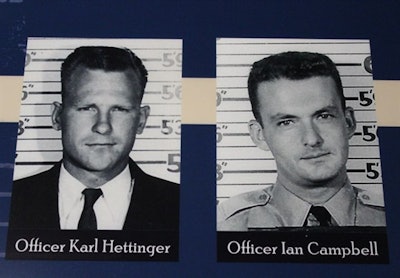 Photo by Greg Meyer.
Photo by Greg Meyer.
It was a memorable day on March 9 at the opening of "The Onion Field" exhibit at the Los Angeles Police Museum marking the 50th anniversary of a police tragedy. By all means, if you are in Los Angeles, come see the exhibit.
Imagine visiting with the families and descendants of murdered LAPD Officer Ian Campbell and his partner Karl Hettinger, now also deceased, and speaking with author and former LAPD Sergeant Joseph Wambaugh, who has spent more than half his life telling the story of "The Onion Field." I did those things that day, and doing so caused me to reflect beyond the tragedy itself.
"The Onion Field" was one of those occasional police incidents that changes the game for all of us in law enforcement. Prior to this incident, officers were occasionally disarmed by suspects, who then fled without doing violence. In Los Angeles alone in the weeks prior to "The Onion Field," three officers were known to have been unarmed, but unharmed.
This time was different. After Campbell and Hettinger (both ex-Marines) were disarmed and kidnapped, Campbell was murdered while standing at gunpoint with his arms up in the air. The crooks (both now deceased) fired at Hettinger. He managed to escape, but only physically. Hettinger was doomed to a life of what we now call post-traumatic stress disorder (PTSD), which was unheard of in the 1960s.
Younger readers may scratch their heads. "How could this have happened?" The answer is found when you realize that in the past half century you have had the benefit of improved tactical training that came at the cost of the blood and minds of officers like Ian Campbell and Karl Hettinger.
Consider these phrases—officer-survival skills; weapon-retention skills; improved holsters; training to not ever give up your gun; the warrior mindset; pre-determined code words between partners that mean, "I'm in trouble, SHOOT HIM NOW;" physical-fitness emphasis; front- and rear-gun takeaway training; close-contact shooting; back-up guns; hideaway guns; and finish the fight.
My first case as a use-of-force expert 23 years ago involved a California Highway Patrol officer who literally saved his own life by killing the suspect with a five-shot back-up gun he wore on his boot. He had lost his duty pistol in a knock-down, drag-out fight. I sure hope YOU carry a back-up gun.
A few days after "The Onion Field" tragedy, legendary LAPD Commander John "Two Gun" Powers—a World War II veteran involved in quite a few shoot-outs—issued what came to be known as "The Hettinger Memorandum." Here are a few lines:
"The police are engaged in a hot war. There are no truces, and there is no hope of an armistice. The enemy abides by no rules of civilized warfare.
"The individual officer, when taking his oath of office, enters a sacred trust to protect his community to the best of his ability, laying down his life if necessary.
"All men return to dust. The manner of a man's living and dying is of paramount importance. Although some moderns have attempted to sap the strength and ideals of this nation by slogans such as 'I'd rather be red than dead,' there are situations more intolerable than death."
"Two Gun" Powers even mentioned that shoving a sharp Number 2 pencil through the suspect's jugular would do the trick. How's that for creative?
My final thoughts: DO NOT give up your gun to a crook. Whatever it takes to save your life, do it. Finish the fight. Win the fight.
And if you have never read Wambaugh's book or seen the movie, please do. Your mind and heart will be impacted forever. The mindset that comes from the lessons of "The Onion Field" may just save your life.
Greg Meyer is a retired LAPD captain who is an internationally known use-of-force expert. He is a member of the POLICE Advisory Board.














